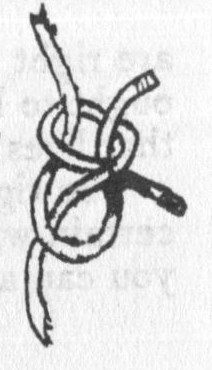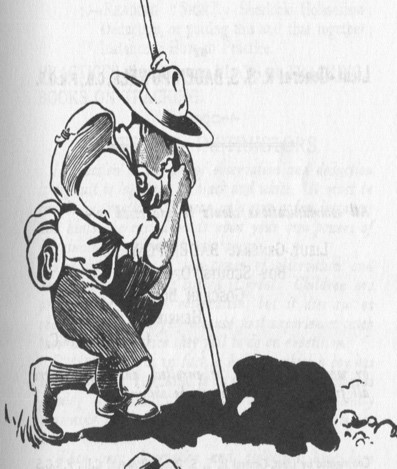CSC REQUIRED KNOTS FOR JUNIOR SKIPPER: EPISODE 2:
David Fraser, CSC Cruising Skipper. 5/17/24
Unknottedness: the quality of being unknotted
-- Onelook.com dictionary
Under Cal Sailing Club’s Junior Skipper requirements, at
https://www.cal-sailing.org/images/official_files/Dinghy17.pdf , are nine knots. Let’s review them, and elaborate as needed.
[This is getting pretty long, so I’m going to tangle with the Sheet Bend and Bowline here, and tackle the rest of the Junior knots in Episode 3. Remember: this series is not How To but more like What About. The pix and video links will give you the tying details.]
Today 5.17.24:
Sheet Bend
Bowline
Next Episode:
Clove Hitch
Round Turn and 2 or 3 Half Hitches
Cleat Knot
Reef (Square) Knot [see also Episode 1]
Figure 8 Stopper
Bead Knot
Slip Knot
SHEET BEND (and Double Sheet Bend)
Animatedknots.com : https://youtu.be/vsj7riFkulE?feature=shared
As I said at the end of Episode 1, this knot needs further examination. It’s one of the most popular knots in any repertoire.

For example, the sheet bend appears in Robert Baden-Powell’s Scouting for Boys (1908).


[Possibly a CSC member (Peter??) in his youth attempting to stab his shadow?] You tell me; YMMV.
It’s offered along with a great deal of imperialist nonsense. Still, there are plenty of useful ideas you may wish to try; I suggest in front of the clubhouse so we can all learn:
In the stillness of the night sounds carry further than by day. If you put your ear to the ground or place it against a stick, or especially against a drum, which is touching the ground, you will hear the shake of horses' hoofs or the thud of a man's footfall a long way off. Another way is to open a knife with a blade at each end, stick one blade into the ground and hold the other between your teeth and you will hear all the better. The human voice, even though talking low, carries to a great distance and is not likely to be mistaken for any other sound.
The point is, the sheet bend is on almost any group’s list. It’s quick, it’s easy to tie, it has elements of a bowline. And yes, it is useful for tying two lines together, especially if their thickness differs. The Double Sheet Bend is twice as, whatever…
The problem is that the sheet bend is not particularly secure. It comes undone rather easily. In this week’s discussion among members, at https://groups.google.com/g/csc-discuss/c/y8IXmBJBfcA , Greg notes that it can work loose. Paul K. says the sheet bend is “more like a sideways square knot, and just as insecure. I've never used one for any practical application.”
Why, then, is the sheet bend on CSC’s required list? I expect because new sailors need a simple way to join two lines quickly – not everything is an emergency – and the only other required bend knot is the Square Knot, which won’t hold well unless reinforced with stopper knots. As I argued in Episode 1, the latter is terrible for any critical need although useful in some cases such as tourniquets and reefing.
There are better, more secure knots than the sheet bend. But it is super easy to learn and will hold in non-critical situations (I hope).
Sarah raised an important question in the Slack discussion: “I love that you're highlighting the zeppelin bend. It's an amazing knot and in my mind should replace the sheet bend for all uses except where you have a whipped loop on one of the two lines that you want to connect (otherwise it can "capsize" and come undone fairly easily). What would it take to swap sheet bend for zeppelin in the CSC required knots list? Some day I'd love to show you my "fishy" method of tying the zeppelin bend.”
Along with the sheet bend, and Paul’s preferred Carrick Bend, let see if we can get people tying the Zeppelin Bend. And Sarah, maybe you can demonstrate the “fishy” Zeppelin Bend after someone shows us Baden-Powell’s auditory technique above. You could get a merit badge.
THE BOWLINE
https://youtu.be/YXRnPES0Qec?feature=shared

There’s much to say about the “King of Knots,” the Bowline. Knotters on YouTube and elsewhere offer tons of info while mispronouncing the name of the knot. If you don’t want other sailors to snicker at your word, say Bó-linn. Like Anne Boleyn, but with the accent on the first syllable.
If on the other hand you’re talking about the line attached to the bow of your boat, then say bow line [bow as in wow, line as in, um, line]. You’ll sound much cooler getting this right.
Couple of points. The bowline is a wonderful knot, but unlike Henry the Eighth, it’s not infallible. It keeps the shape of the big loop even under tension. It’s mostly reliable and robust, although it can shake loose when the tension is sporadic. We should all be able to tie it quickly and correctly. I still have to concentrate when tying it with the small loop on the right vs. left (see link above).
The bowline is great for tying sheets onto a jib clew, or a halyard onto the mainsail. It serves hundreds of other purposes when you need a non-adjusting loop. On this forum we’ve just had a really useful exchange about using bowlines for limited towing.
https://groups.google.com/g/csc-discuss/c/y8IXmBJBfcA
Two other points: there are dozens of bowline variations, so many that I’ll do an episode on them down the road. But in the meantime: also learn the Snap (Quick) Bowline. It’s amazing and once you get it, it’s almost impossible to screw up.
Here’s a fine video: https://youtu.be/aNMB6qd0ets?feature=shared
Remember to get the slip knot correct at the start: reach through the small loop and pull up a slice of the standing part, not the tail / working end that’s making the big loop. Tighten the slip knot but not too much. Create the big loop and pop the end through the slip knot, then fold it back on itself and pinch. You can go through either direction. Pull the standing part and the knot collapses [capsizes] into a true bowline.
Same knot from Steve Colgate, whose book we use when working on Senior. https://youtu.be/gMdYKmuqRQs?feature=shared
Alla prossima, David
# # #

